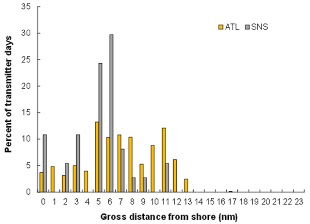Results - Sturgeon

Atlantic and shortnose sturgeon are diadromous, which means that they spawn in freshwater habitats but spend some portion of each year in the ocean. As such, acoustic receiver arrays should provide an excellent data collection platform to document when and where sturgeon occur in coastal ocean waters. Both species are listed as "endangered" under the Endangered Species Act (shortnose since 1973, Atlantic since 2012); thus, it is especially important to improve understanding of when, where, and why these species occur in the coastal ocean.

Across tagged animals, more than 3,750 days of detection were recorded for Atlantic sturgeon compared to just 36 days of detection for shortnose sturgeon. Only 6% of Atlantic (and no shortnose) sturgeon detection days occurred between May and October. Atlantic sturgeon detected in coastal waters off SC and GA were tagged by 10 research groups from eight states between CT and GA. In contrast, shortnose sturgeon detected in these same areas were predominantly tagged and detected in SC waters.

As conveyed by animations for each species below, peak acoustic detection with respect to distance from shore varied across arrays for Atlantic and shortnose sturgeon. As a general rule, though, observation frequency for both species peaked five to six miles from shore. For shortnose sturgeon, observation frequency declined with increasing distance from shore; however, such decline was less evident for Atlantic sturgeon, predominantly due to variability within arrays.
